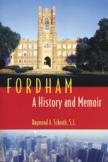The Way We Were
A school, particularly a Jesuit school, is a family—a community of brothers and sisters who share a common name as alumni, a common ancestry in the generations that came before, common parents in the faculty, a common Ignatian culture and a common responsibility for the generations to come.
A family reflects, and is influenced by, the story of the larger community in which that family dwells, be it a parish, a neighborhood, a nation, an ethnic group or a church. Fordham: A History and Memoir is a largely successful attempt to tell the story of one unique academic family, and of the neighborhood, nation, church—and society—of which it is a part.
Raymond Schroth, S.J., media critic for the National Catholic Reporter, former book review editor at Commonweal, author of six books and a professor of humanities at St. Peter’s College in Jersey City, N.J., is the teller of this family’s tale. He has long been an active member of the Fordham University family, having graduated from the school in 1955. He returned in the 1960’s as a scholastic and later taught journalism, American Studies and literature. He also ministered to students in the chapel and residence halls, and plunged himself into some of the darkest moments his university family faced.
As the title suggests, this is both history and personal memoir. Schroth has used old issues of The Ram (the student newspaper), The Monthly (the student magazine) and all the other typical sources, to find a few representative people, some famous and some utterly obscure, whose own stories vividly and economically give the reader both a comprehensive history of the institution and a real flavor of the time. (The book never becomes that most narrow of things, an “institutional history” geared at alumni like a sort of extra yearbook for the chronically nostalgic.)
As a memoirist Schroth, with a few anecdotes, gives the reader a powerful experience of what it means to be student, Jesuit priest and professor, but he balances his personal contributions to the text with those of others in different ages.
Yes, the real daily life of the dorms of Schroth’s 1950’s undergraduate years is humorously captured, but so are the evening visits of Edgar Allan Poe (who liked the Jesuits because “they smoked and they drank, and they played cards, and they never said a word about religion”). We have Robert Gould Shaw, the “boy colonel” who led the 54th Massachusetts regiment in the Civil War (the subject of the mostly accurate movie “Glory”), who spent the equivalent of high school at Fordham, whining about Jesuit discipline and the lousy food in letters home (he had similarly bitter complaints about Harvard later), and matter-of-factly recounting his exploits and those of other horrifying little boys (the kiddies catch squirrels on the woodsy campus, and “tame” them by nearly drowning them in barrels of water).
There is Michael Nash, a scholastic who prepared for his life at Fordham by attending St. Mary’s College in Kentucky, one of Fordham’s predecessors, where the boys had such entertaining diversions as burning down their dormitory after a paddling, stabbing each other in knife fights, getting drunk on moonshine and pulling pistols on their Jesuit teachers.
There is George Roach, who nearly drowned on Omaha Beach in the opening minutes of the D-Day invasion nearly a century later. G. Gordon Liddy’s, Denzel Washington’s and Mary Higgins Clark’s recollections are here, but there are also the stories of forgotten leaders of student protests, from a time when Fordhamites were as likely to storm the president’s office over a faculty tenure decision as over the Vietnam War.
There are also the author’s own memories of the titanic faculty battles that centered around the person of Fordham’s most controversial president, Leo McLaughlin, who attempted to revolutionize (or secularize) Fordham, won a generation of critics within and without the Society of Jesus, left the Society to marry but returned to die in the Jesuit infirmary at Fordham—a tragic figure in Schroth’s eyes.
Schroth not only details the internal fights over Fordham’s football program, the equally bitter battle over the theater program and the periodic struggle to lift Fordham out of academic mediocrity. He uses these intramural wars to instantiate the larger tensions between Catholic scholars and anti-intellectuals (Schroth happily devotes a long passage to Orestes Brownson), between ideological factions among American Catholics, between factions within the Society of Jesus itself (over what the society should be, what its mission should be, what its universities should be, what a Jesuit should be) and between the facets of the Bronx and New York City communities whose people are a part of Fordham and of whom Fordham students are members.
For some, the book may assume a bit too much knowledge on the part of the reader about the history of Catholicism in America, or of education, or of the Society. Schroth also uses a flashback/flashforward technique that some readers will find a little distracting; but others will enjoy the stream of consciousness effect, and find that the stories flow logically.
Even readers who have never visited Fordham University will find this a valuable work that captures, in the story of this one family, the experience of 159 years of Jesuit, Catholic and American educational history.
This article also appeared in print, under the headline “The Way We Were,” in the August 26, 2002, issue.








